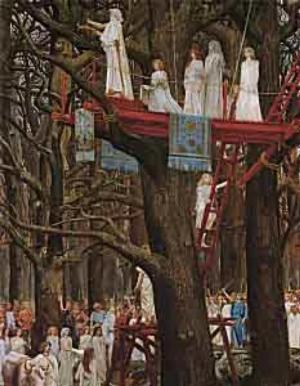| Author: | Maurice Leblanc | ISBN: | 9781465556011 |
| Publisher: | Library of Alexandria | Publication: | July 29, 2009 |
| Imprint: | Library of Alexandria | Language: | English |
| Author: | Maurice Leblanc |
| ISBN: | 9781465556011 |
| Publisher: | Library of Alexandria |
| Publication: | July 29, 2009 |
| Imprint: | Library of Alexandria |
| Language: | English |
EVERY tripper by the banks of the Seine must have noticed, between the ruins of Jumieges and those of Saint-Wandrille, the curious little feudal castle of the Malaquis, proudly seated on its rock in mid-stream. A bridge connects it with the road. The base of its turrets seems to make one with the granite that supports it, a huge block detached from a mountain-top and flung where it stands by some formidable convulsion of nature. All around, the calm water of the broad river ripples among the reeds, while wagtails perch timidly on the top of the moist pebbles. The history of the Malaquis is as rough as its name, as harsh as its outlines, and consists of endless fights, sieges, assaults, sacks and massacres. Stories are told in the Caux country, late at night, with a shiver, of the crimes committed there. Mysterious legends are conjured up. There is talk of a famous underground passage that led to the Abbey of Jumieges and to the manor-house of Agnes Sorel, the favourite of Charles VII. This erstwhile haunt of heroes and robbers is now occupied by Baron Nathan Cahorn, or Baron Satan as he used to be called on the Bourse, where he made his fortune a little too suddenly. The ruined owners of the Malaquis were compelled to sell the abode of their ancestors to him for a song. Here he installed his wonderful collections of pictures and furniture, of pottery and carvings. He lives here alone, with three old servants. No one ever enters the doors. No one has ever beheld, in the setting of those ancient halls, his three Rubens, his two Watteaus, his pulpit carved by Jean Goujon and all the other marvels snatched by force of money from before the eyes of the wealthiest frequenters of the public sale-rooms. Baron Satan leads a life of fear. He is afraid not for himself, but for the treasures which he has accumulated with so tenacious a passion and with the perspicacity of a collector whom not the most cunning of dealers can boast of having ever taken in. He loves his curiosities with all the greed of a miser, with all the jealousy of a lover
EVERY tripper by the banks of the Seine must have noticed, between the ruins of Jumieges and those of Saint-Wandrille, the curious little feudal castle of the Malaquis, proudly seated on its rock in mid-stream. A bridge connects it with the road. The base of its turrets seems to make one with the granite that supports it, a huge block detached from a mountain-top and flung where it stands by some formidable convulsion of nature. All around, the calm water of the broad river ripples among the reeds, while wagtails perch timidly on the top of the moist pebbles. The history of the Malaquis is as rough as its name, as harsh as its outlines, and consists of endless fights, sieges, assaults, sacks and massacres. Stories are told in the Caux country, late at night, with a shiver, of the crimes committed there. Mysterious legends are conjured up. There is talk of a famous underground passage that led to the Abbey of Jumieges and to the manor-house of Agnes Sorel, the favourite of Charles VII. This erstwhile haunt of heroes and robbers is now occupied by Baron Nathan Cahorn, or Baron Satan as he used to be called on the Bourse, where he made his fortune a little too suddenly. The ruined owners of the Malaquis were compelled to sell the abode of their ancestors to him for a song. Here he installed his wonderful collections of pictures and furniture, of pottery and carvings. He lives here alone, with three old servants. No one ever enters the doors. No one has ever beheld, in the setting of those ancient halls, his three Rubens, his two Watteaus, his pulpit carved by Jean Goujon and all the other marvels snatched by force of money from before the eyes of the wealthiest frequenters of the public sale-rooms. Baron Satan leads a life of fear. He is afraid not for himself, but for the treasures which he has accumulated with so tenacious a passion and with the perspicacity of a collector whom not the most cunning of dealers can boast of having ever taken in. He loves his curiosities with all the greed of a miser, with all the jealousy of a lover















